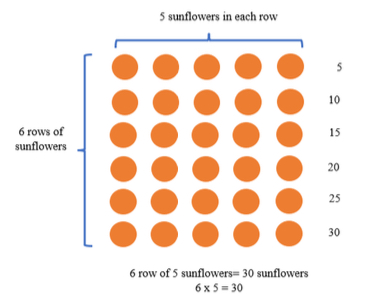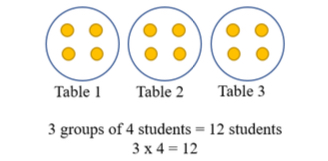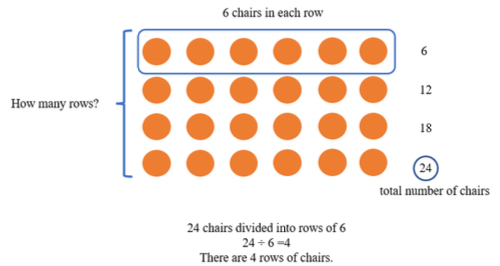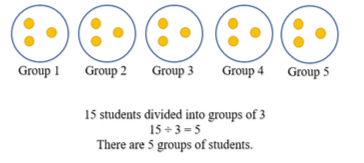Explore multiplication of two whole numbers with products from 0 to 144, and related division facts.
Instruction includes equal groups, arrays, area models and equations.
| Name |
Description |
| Skip Counting to Multiplying | Students will build a conceptual understanding of multiplication skip counting on a 50 board. Students will connect the skip counting to multiplication. |
| Partial Products with Arrays | In this inquiry-based lesson, students will use the distributive property to find partial products of arrays to solve multiplication problems. They will also move from a concrete representation of arrays using manipulatives to a pictorial representation. |
| Cheezy Arrays | This lesson is a hands-on activity that includes multiplication using arrays. The lesson also serves as a great transition from repeated addition to multiplication. |
| “Shoot for the Stars to Introduce Multiplication” | Students will learn how multiplication is related to repeated addition and use different strategies to find the product of equal groups situations. |
| Each Orange Had 8 Slices: Multiplying Equal Groups | Students will learn how to represent and count equal groups through the use of literature and situational story problems. Using the book Each Orange Had 8 Slices, students will use manipulatives to find the total number of objects in a collection of equal groups. Students will learn to write corresponding multiplication equations. |
| How many Circles? How many Stars? | “How many Circles? How many Stars?” is an activity that will give students a visual representation of multiplication. It will also help students see multiplication as the combining of equal-size groups that can be represented with a multiplication equation. |
| Hip, Hip, Array! | Students will develop their understanding of thinking in equal groups and arrays by building arrays using hands on activities. |
| The Poo on my Shoe! Multiplying with five,ten, and two | The lesson introduces the bridge between repeated addition and multiplication. Students will be able to work independently or with a partner and complete charts to demonstrate understating of equal groups and multiplication. |
| From Array to Van De Walle 100-Dot Matrix | This lesson builds upon student knowledge of arrays to using the Van de Walle 100-Dot Matrix model to solve multiplication problems involving rows and columns. |
| The Array Frame, your best friend | In this lesson, students will learn to use the structure of array frames to build familiarity and fluency with the array as a tool. Students will explore multiplication by solving several multiplication word problems involving rows and columns situations using the array as a representation. |
| Circles and Stars | This is an introductory lesson to prepare students to move from using repeated addition to using multiplication to represent equal groups situations. |
| Zero on a Hero (Exploring the Zero Property of Multiplication) | Students will explore the Zero Property of Multiplication using array and equal-group models for multiplication. Students will model story problems, translate problems into multiplication facts, and identify patterns in a set of multiplication facts to develop understanding of the Zero Property of Multiplication. |
| One with a Bun (Exploring the Multiplicative Identity Property of 1) | In this lesson students will explore the Multiplicative Identity Property of 1, using array and equal-group models for multiplication. Students will model story problems, translate problems into multiplication equations, and identify patterns in a set of multiplication facts to develop understanding of the Multiplicative Identity Property of 1. |
| Group Singing Lessons | Students will decide which performing arts facility their principal should recommend for group chorus singing lessons. They will apply multiplication, division, and time skills for telling time to the nearest minute and time intervals. Students will work collaboratively as a group to analyze this Model Eliciting Activity (MEA), and engage in collaborative discussion that involves higher level critical thinking. They will write letters on which performing arts facility is the best choice.
Model Eliciting Activities, MEAs, are open-ended, interdisciplinary problem-solving activities that are meant to reveal students’ thinking about the concepts embedded in realistic situations. Click here to learn more about MEAs and how they can transform your classroom. |
| Let's Multiply using Groups and Arrays | In this lesson, students will use pictures in arrays and groups to write multiplication story problems, write an equation, solve the problem, and identify the factors and products. |
| Product Productions | The lesson uses a movie making theme to teach the characteristics and purpose of arrays, as well as the vocabulary, factor and product. |
| Just Group It | Students will be able to use counters to create equal groups and write multiplication equations to represent these representations. |
| Multiply by Multiples of 10 with Number Cubes | In this lesson students will use various strategies to multiply one-digit numbers by multiples of 10 within the range of 10-90. The strategies will encompass the Distributive, Commutative, and Associative properties, place value, number lines, base-ten blocks, diagrams, hundreds chart. Students will play a game with number cubes to practice this multiplication. |
| Arrays Show the Way to the Multiplication Chart | This is an introductory lesson to explore the use of arrays to solve multiplication problems. Students build arrays and save the arrays in a class Multiplication Chart. They learn to use arrays to find products and factors, and by placing them in the Multiplication Chart, they learn how to read the chart. They learn how to write equations to represent situations that are modeled with arrays. An overall theme is the organization of the multiplication chart and how it includes arrays within. |
| Hungry Zero | The definition of the Zero Property of Multiplication will be analyzed, modeled and practiced. |
| Giddy Up, Round Up: Relating Division to Multiplication | In this lesson, students will learn to solve division problems by relating them to multiplication facts. Practice materials focus on the 6's and 8's multiplication facts. |
| Great Estimations! | In this lesson, students will deepen their knowledge of using equal groups in multiplication and their ability to visualize the quantity of an item in a given object. They will use problem-solving skills and see the value in using benchmarks. |
| Efficient Multiplication | Students will engage with questions to evaluate the students' abilities to select and apply multiplication strategies with fluency and efficiency. The focus of the lesson is decomposing numbers to multiply using the Distributive property and understanding and applying the Commutative property. Then, students will reinforce decomposing of factors while playing Decomposition of Factors. The lesson concludes with a real world application problem on an Exit Slip. |
| Pet Store Partitive Division | In this lesson students will model partitive division through the real-world activity of a pet store owner. |
| Chip Chip Array! | Students work together to create arrays to represent given numbers. |
| Array to Multiply | In this lesson, students will understand the concept of arrays and will be able to create/draw an array for multiplication sentences. Engaging center game is used to help students with concrete visual representation of multiplication sentences. |
| Tasty Algebra: Using toasted O cereal to find the missing factor in a multiplication equation. | In this lesson students will use Cheerios to solve multiplication equations relating 3 whole numbers from word problems that include missing factors ranging from one through ten. Students will also argue the validity of multiplication equations that include missing factors and products with corresponding word problems. |
| Apples, Oranges, and Bananas of Math? | In this lesson, the students will work in independently or in small groups to write equations to represent situations as well as their own math riddles around the concepts of multiplication. The teacher will use the book, The Grapes of Math by Greg Tang, to support this lesson. |
| Area Isn't Just for Squares | This lesson helps students make the connections between area and multiplication using square tiles. |
| How Many Seeds in a Pumpkin? | In this hands-on math exploration, students will use knowledge of estimation and multiplication to develop strategies for estimating how many seeds are in a medium-sized pumpkin. |
| Magnificent, Amazing Multiplication Arrays! | In this lesson students will be creating, describing, and analyzing arrays as they relate to multiplication. In addition, they will be working on hands on activities that allow them to justify their answers and prove their reasoning. |




